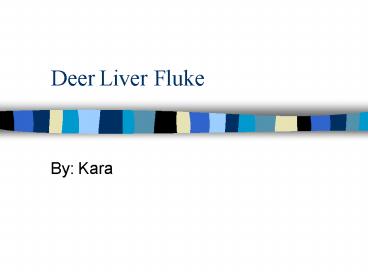Deer Liver Fluke - PowerPoint PPT Presentation
1 / 12
Title:
Deer Liver Fluke
Description:
15-30mm wide by 30-100mm long by 2-5mm thick. Where it likes to live ... and Canadian report the fluke in moose, elk, white-tailed deer, mule deer, bison, ... – PowerPoint PPT presentation
Number of Views:372
Avg rating:3.0/5.0
Title: Deer Liver Fluke
1
Deer Liver Fluke
- By Kara
2
Basic Information
- Scientific name Facioloides magna from Latin
fasciolaband, magnalarge - Class Trematode (Flukes)
- Phylum Platyhelminthes (Flatworms)
3
Description
- Flat, enlongated, oval, look like blood
suckers/ leaches - Purple-gray color
- looks like a blood clot (in liver)
- Surrounded by fibrous capsule, bathed in a dark,
muddy-appearing fluid. - 15-30mm wide by 30-100mm long by 2-5mm thick
4
Where it likes to live
- The natural host is the deer, which is also a
reservoir host - found in captive elk, but has not been observed
in free elk. - The fluke can also infect cattle, sheep, and
llama.
- Some other states and Canadian report the fluke
in moose, elk, white-tailed deer, mule deer,
bison, and yak. - It has also been reported in red deer, fallow
deer, and sambar deer in Europe.
5
Steps to infection
- Adult flukes deposit eggs in the ducts and
cavities of the liver of the host. - the eggs pass to the intestinal tract and are
eliminated in the feces. - The eggs need moisture for development, and will
hatch in moist feces or shallow water
6
Steps continued
- It takes about 25 days for eggs to hatch into the
next stage, miracidia. - Miracidia enter the snail as its next host
- In the snail, development proceeds to a
sporoscyst form which can produce redia and
daughter redia
- these redia produce cercaria, the final
intramolluscan form - Cercaria leave the redia while immature, and
leave the snail after about four days
7
Once outside the snail.
- cercaria encyst on vegetation
- these encysted forms are called metacercaria.
They represent infective larvae, or young flukes,
that are very resistant to the elements
- These are ingested by deer (or other host)
- the larvae penetrate the wall of the intestine,
and migrate to the liver. - The flukes develop in about three months.
- If all conditions are right, the cycle can be
completed in five months.
8
Damage to sheep
- In sheep these parasites do great damage to the
liver - uninterrupted migration throughout the liver
causes massive hemorrhage and a peritonitis may
develop - sheep are the only host where the fluke causes
such damage two or three of these parasites can
cause death in a sheep.
9
No damage here
- Cattle, bison, yak, and deer will encapsulate
mature flukes in the liver, restricting their
migration, and damage - under experimental conditions, mule deer fawns
and elk calves have died from fluke infection.
10
Finding a Fluke
- examining visually for the parasites by making
slices at 0.5 inch intervals through the entire
liver - Fibrous capsules may be visible on the lung
surface
- It is also possible to diagnose flukes by
microscopic examination of the feces for eggs of
the parasite.
11
Treatment
- fasciolicide drugs have been developed which are
effective against mature Flukes. - Triclabendazole in a medicated corn bait was
given to white-tailed deer in a wildlife refuge
in Texas
- resulting in the population of liver flukes being
significantly lower
12
Summary
- Deer liver flukes are not harmful to deer. The
life cycle takes about 5 months for the Fluke and
it spends 4 days living in a snail before it
makes its way into the deer. - (all information from http//www.michigan.gov/dnr/
Pictures from google and that website)































![Microbiology Spring Quarter Practice Final (137 qs) [Formatting by Ray, Explanations by Kevin Peng] Compiled 5/18/08 PowerPoint PPT Presentation](https://s3.amazonaws.com/images.powershow.com/A1259793942hutIR.th0.jpg?_=20140121117)